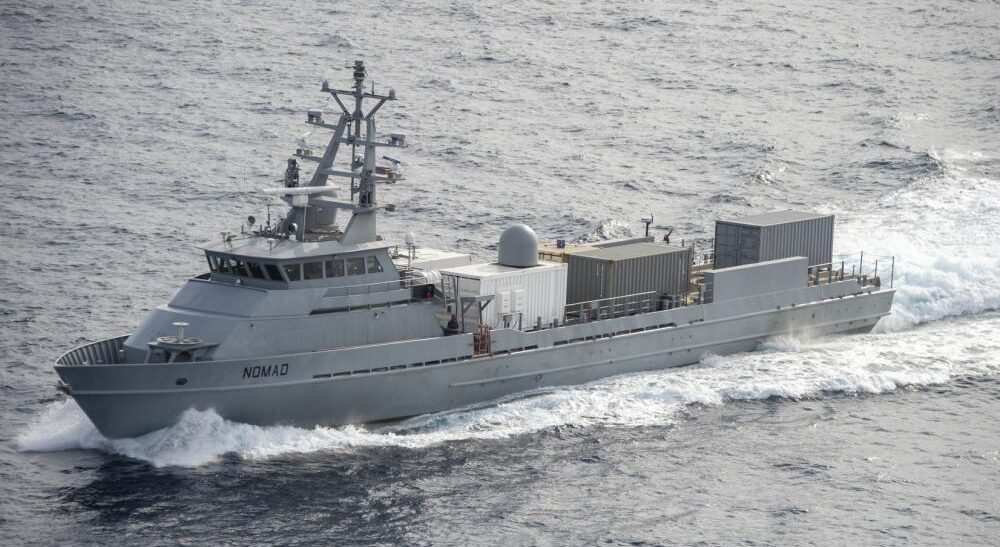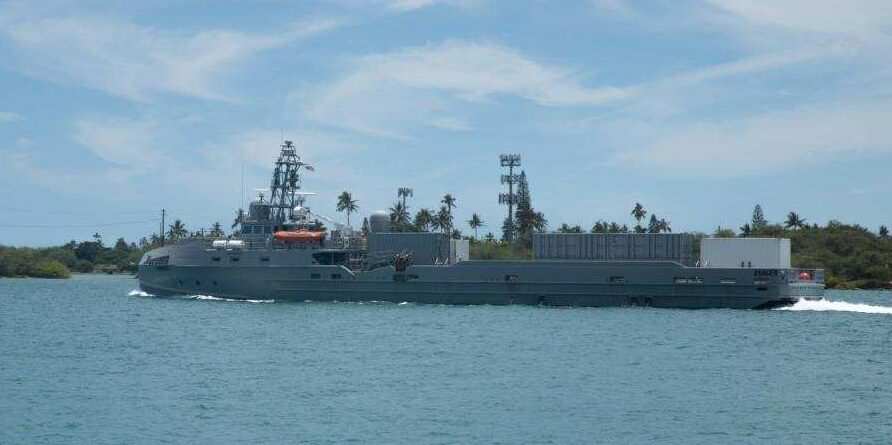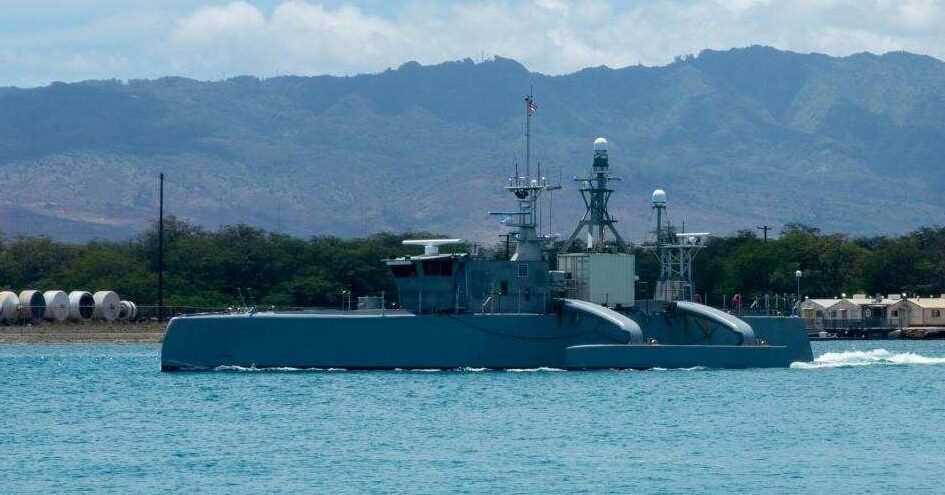Docked by the sunken wreckage of a 1909 dreadnought, two unusual vessels are helping the U.S. Navy navigate its way toward its future. The unmanned Nomad and Ranger, which resemble seagoing flatbed trucks loaded with conex containers, represented the debut of uncrewed surface vessels at the giant biannual Rim of the Pacific exercise.
RIMPAC’s experimentation allows the Navy to test out and learn from the AI capabilities in its unmanned platforms, Adm. Mike Gilday, chief of naval operations, told Defense One last month.
“This exercise is helping us-at a classified level I can’t talk about-give us the ability to separate sensor from shooter, to exchange data between unmanned platforms in a way that we haven’t before. To leverage AI capabilities at the tactical edge in a way that we haven’t before.”
The conex boxes and the domes that stud the robot ships’ masts held a “various array of passive sensors” for intelligence, surveillance, reconnaissance, and targeting, said Cmdr. Jeremiah Daley, who commands Unmanned Surface Vessel Division One, the parent unit for Ranger and Nomad. The optionally manned ships can also carry active sensors, like radar, and even weapons, like the SM-6 missile that Ranger fired last September.

During the exercise, Nomad and Ranger set sail from Pearl Harbor under the control of an operations center in San Diego. Once at sea, they fed data from their sensors to nearby destroyers, Daley said. The goal is to create uncrewed ships that can operate essentially by themselves, while responding to the needs of the crewed ships nearby.

“We’re testing out how to combine that and make it to a point where it’s automated enough to be on its own, functioning, while still communicating with a manned platform from a command-and-control standpoint,” he said. “So that the manned platform is using the unmanned surface vessel as an extension of its own combat system.”

Daley also had two other fully uncrewed vessels at RIMPAC, Sea Hunter and Seahawk, each controlled by a destroyer crew who practiced navigating the smaller vessel and integrating its data with the ship’s combat systems. The destroyer’s crew was also improving the tactics, techniques and procedures for the ship, he said.
The Seahawk was controlled by a destroyer that reported to a Singaporean commander who worked under South Korean Navy Rear Adm. Sangmin Ahn, who led the exercise’s Combined Task Force 176. The leadership used the unmanned ship and its sensor data to support the entire task force, Daley said.

He declined to detail what lessons the Navy was learning operationally with the unmanned surface vessels at RIMPAC, citing their sensitive nature, nor would he say whether his surface ships were interacting with the other unmanned vessels.
Daley did say that the autonomy associated with the ship navigation was “meeting our requirements” and feedback has been “very good,” especially from the manned ships.
“We don’t always get to interact with them in a dynamic environment that’s some combination of operational and experimentation at the same time. And that’s what we’re doing here,” Daley said. “And getting that direct feedback from a manned ship over a sustained period of time—a week, 10 days, vice two or three days—gives you that much more data and sort of feedback to get the next iteration of how we’re going to do something.”
The work being done with the unmanned ships at RIMPAC is “vitally important,” said CNO Gilday.
“Operational experimentation for unmanned can’t just be a flash in the pan, it actually has to be connected to a key operational problem that we’re trying to solve,” he said.
His new Navigation Plan calls for a “hybrid fleet” of about 500 manned and unmanned ships by 2045—but wants the Navy to get going a lot sooner. By the mid- to late 2020s, he wants the Navy to deploy a large unmanned vessel with a carrier strike group.
Meanwhile, on July 29, the Navy announced that the Unmanned Influence Sweep System, a counter-mine surface vessel, had become the first unmanned surface vessel to reach initial operating capability. The unmanned vessel can be launched from a littoral combat ship, from shore, or non-military vessels.
Congress has been hesitant in the past to fund unmanned vessels still going through research, test, and development. This year’s RIMPAC had the highest number of congressional members and staffers visit in the exercise’s history, according to a RIMPAC spokesperson. Gilday said he hoped they took away from their visit that unmanned systems are not a luxury, but a necessity “if we’re going to operate in a distributed manner against any adversary.”
“We’re the only service that operates from the seabed to space,” he said. “And I think that we can leverage unmanned in a way that few -well, in ways that other services cannot, in order to make ourselves, I think, a valuable part of the joint force, whether it’s in competition or whether it’s in a conflict.”
___
© 2022 Government Executive Media Group LLC
Distributed by Tribune Content Agency, LLC.



